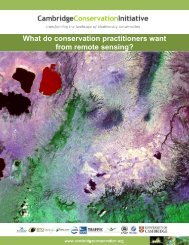CONSERVING BIODIVERSITY & DELIVERING ECOSYSTEM SERVICES
conserving biodiversity & delivering ecosystem services
conserving biodiversity & delivering ecosystem services
You also want an ePaper? Increase the reach of your titles
YUMPU automatically turns print PDFs into web optimized ePapers that Google loves.
Many methods exist for identifying, measuring and valuing<br />
ecosystem services yet the majority are highly technical,<br />
expensive and not well grounded at the site level. This study<br />
was undertaken using a new ‘toolkit’ of methods for assessing<br />
ecosystem services, developed by a collaboration of academic<br />
institutions and conservation practitioners.<br />
The toolkit provides practical guidance and methods that<br />
attempt to find a balance between simplicity and utility in<br />
developing robust scientific information for decision-makers.<br />
It focuses on understanding the impacts of actual and<br />
potential changes on ecosystem services at individual sites,<br />
owing to policy or management actions that affect the type of<br />
land use and its management at the site.<br />
This methodology estimates the value of ecosystem services<br />
in the current state and the most likely alternative state of the<br />
site (for example, after conversion to agriculture), and<br />
presents the results as a comparison, so that decision-makers<br />
can assess the net consequences of such a change, and hence<br />
the costs and / or benefits of conservation for human wellbeing<br />
(see figure).<br />
Rapid appraisal<br />
To assess the importance of Nepal’s 27 IBAs for delivery of<br />
ecosystem services, an expert consultation meeting was held<br />
that had representation from site managers or local<br />
conservation groups, or others with relevant knowledge, from<br />
all the IBAs. Together, these experts completed a ‘rapid<br />
appraisal’ of the site, including an overview of the habitats,<br />
the ecosystem services delivered by the site, drivers of change<br />
at the site and the potential impacts that this may have on<br />
stakeholders at a range of scales. It should be noted that this<br />
exercise was based on expert knowledge rather than on<br />
empirical scientific data. Some inconsistencies in the reported<br />
results may occur due to limitations in the knowledge of the<br />
participants and the difficulty in predicting how future<br />
changes may affect services.<br />
Case Studies<br />
Four IBAs were selected for further study, and appropriate<br />
quantitative methods were chosen from the toolkit to<br />
measure and value the ecosystem services they provide<br />
compared to a plausible alternative state (usually a change in<br />
the land cover). These methods are summarised opposite.<br />
Global climate regulation<br />
Carbon storage in above-ground and below-ground biomass<br />
was estimated using one of three methods: (1) reference to<br />
IPCC standard tables; (2) ‘transfer’ of values from similar sites;<br />
(3) simple field surveys to quantify the mass of living<br />
vegetation in different habitats. Greenhouse gas emissions<br />
were estimated using IPCC values for appropriate habitat<br />
types. Data were extrapolated based on values per habitat per<br />
hectare and presented as economic values where relevant.<br />
Water<br />
Water provision and water quality were estimated using data<br />
from either water companies, questionnaire surveys or the<br />
online tool ‘WaterWorld’ which enables water provision, soil<br />
erosion and sedimentation to be modelled and a comparison<br />
made between current and alternative states.<br />
Harvested wild goods<br />
The harvesting of wild goods was quantified through<br />
participatory methods including stakeholder workshops and<br />
household surveys. Methods quantified the annual amount<br />
harvested, the unit value and related costs (including<br />
opportunity costs). The selected goods were extrapolated<br />
according to average per hectare values and were presented<br />
as economic values where relevant.<br />
Cultivated goods<br />
Cultivated goods were quantified through participatory<br />
methods including stakeholder workshops and household<br />
surveys or through information obtained from informed<br />
individuals. Methods quantified the annual amount<br />
cultivated, the unit value and related costs (including<br />
opportunity costs). Average values per hectare were applied<br />
to the area under cultivation and presented as economic<br />
values where relevant.<br />
Nature-based recreation<br />
Data on the number of visitors to a site were gathered<br />
through published reports on visits to sites or interviews with<br />
key informants. The economic contribution from tourism was<br />
deduced from interviews with visitors to estimate travel costs<br />
per visit. The proportion of that value coming from naturebased<br />
tourism was estimated through a simple choice<br />
question about the alternative state.<br />
Stages in assessing ecosystem services at sites, as outlined in the ‘toolkit’<br />
Preliminary work<br />
■ Define site,<br />
based on<br />
biological<br />
importance and<br />
perceived<br />
threats<br />
■ Explore policy<br />
context<br />
■ Identify and<br />
engage<br />
stakeholders<br />
Rapid appraisal<br />
■ Identify habitats<br />
and drivers of<br />
change<br />
■ Identify<br />
services and<br />
beneficiaries<br />
Identify<br />
alternative state<br />
■ Given drivers of<br />
change and<br />
policy context<br />
Methods selection<br />
■ Select relevant<br />
services to<br />
assess<br />
■ Identify how<br />
to assess<br />
alternative state<br />
■ Select<br />
appropriate<br />
methods for<br />
each service<br />
Data aquisition<br />
■ Collect/collate<br />
data for site in<br />
current state<br />
Data aquisition<br />
■ Collect/collate<br />
data for site in<br />
alternative state<br />
Analysis and<br />
communication<br />
■ Analyse data to<br />
compare current<br />
and alternative<br />
states of site<br />
■ Identify potential<br />
changes in<br />
distribution of<br />
benefits<br />
■ Communicate<br />
messages




